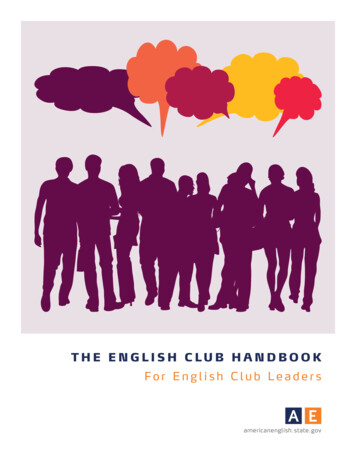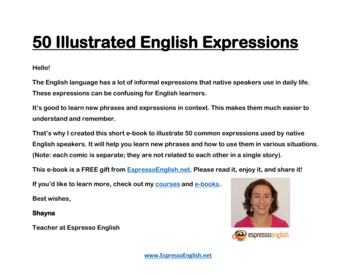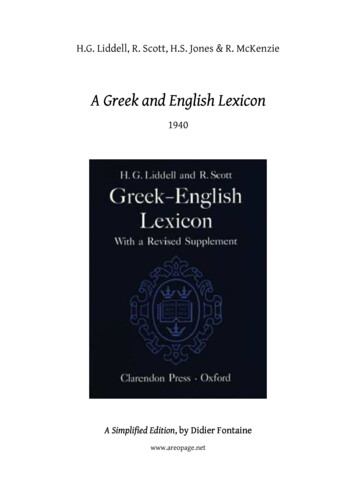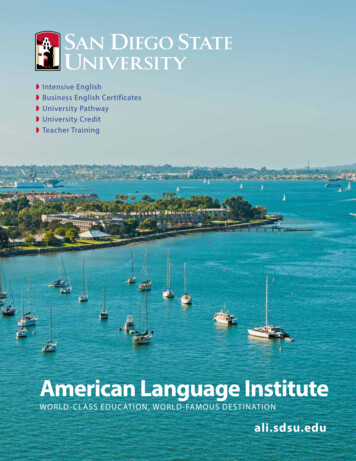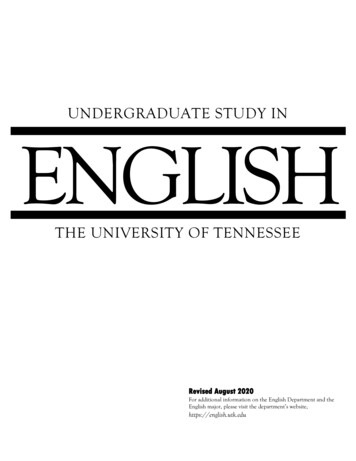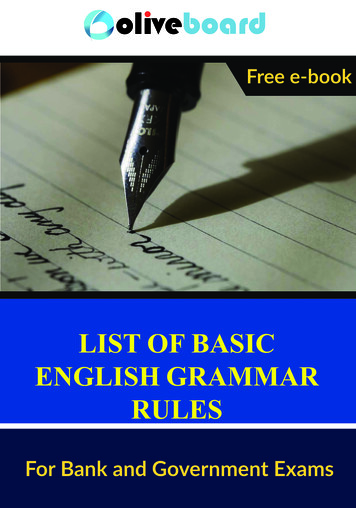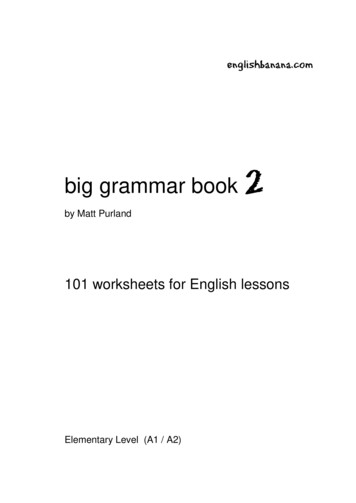
Transcription
STEFANIE LETHBRIDGE AND JARMILA MILDORF:Basics of English Studies:An introductory course for students ofliterary studies in English.Developed at the English departments of theUniversities of Tübingen, Stuttgart and Freiburg4. PoetryTable of Contents:4.1. What Is Poetry? . 1424.1.1. Outward Indications . 1424.2. Types of Poetry . 1444.2.1. Lyric Poetry . 1444.2.2. Narrative Poetry . 1454.2.3. Descriptive and Didactic Poetry . 1464.3. Prosodic Features: Metre and Rhythm . 1464.3.1. Metre . 1464.3.1.1. Accentual Metre . 1474.3.1.2. Syllabic Metre . 1484.3.1.3. Accentual-Syllabic Metre . 149SO WHAT? . 1514.3.1.4. Free Verse . 1524.3.1.5. Maximisation Principle and Metrical Grid . 1524.3.1.6. Metrical Deviation . 1534.3.1.7. Substitutions . 1534.3.1.8. Recitation . 154SO WHAT? . 1544.3.2. Rhythm . 1564.3.2.1. Pauses at the End of Lines . 156SO WHAT? . 1584.3.2.2. Pauses within Lines . 1584.3.2.3. Elisions and Expansions . 1584.3.2.4. Vowel Length and Consonant Clusters . 1594.3.2.5. Modulation . 1614.4. Prosodic Features: Sound Patterns . 1624.4.1. Rhyme . 1624.4.2. Alliteration, Assonance, Onomatopoeia . 164SO WHAT? . 1644.5. Verse Forms and Stanza Forms . 165SO WHAT? . 1724.6. Form and Meaning in Poetry . 173Bibliography: Poetry . 175Basics of English Studies, Version 12/03, Poetry141
4. Poetry4.1. What is Poetry?To ask ‘What is poetry?’ is very much like asking ‘What is literature?’ and infact the answers to both these questions overlap: Poetry is perceived asfictional, it uses specialised language, in many cases it lacks a pragmaticfunction, it is also ambiguous (see Basic Concepts ch. 1.2).4.1.1. Outward IndicationsIn addition, there are a number of outward signs that indicate a poem: Mostobviously, the individual text lines in poetry do not fill the entire width of thepage. Thus, before they have actually started reading, readers of poetry aregiven an instant indication that what they are going to read is probably a poem.In consequence, a reader’s attention is likely to focus on ‘poetic features’ of thetext.Poetry is often associated not only with specialised language but with avery dense use of such specialised language. Poems usually try to express theirmeaning in much less space than, say, a novel or even a short story. AlexanderPope once explained that he preferred to write poetry even when he wroteabout philosophy because it enabled him to express himself more briefly(Pope, Preface to An Essay on Man, 1734). As a result of its relative brevity,poetry tends to make more concentrated use of formal elements, it displays atendency for structural, phonological, morphological and syntacticoverstructuring, a concept which originated in formalist and structuralistcriticism. It means that poetry uses elements such as sound patterns, verse andmetre, rhetorical devices, style, stanza form or imagery more frequently thanother types of text. Obviously, not all poems use all these elements and not allverse is poetry, as John Hollander remarks (Hollander 2001: 1). Especiallymodern poets deliberately flaunt reader expectations about poetic language (seethe ‘found poem’ in ch. 1.2.). Nonetheless, most poetry depends on theaesthetic effects of a formalised use of language.Some people associate poetry with subjectivity and the expression ofintense personal experience. While this is true for some poetry, especiallylyrical poetry, there are a great number of poems this does not apply to; forexample narrative poems like Scott’s Marmion or didactic and philosophicalpoems like Pope’s Essay on Man or John Philips’ Cyder. Just as it is oftenmisleading to identify the author of a novel with its narrator, one should notassume that the author of a poem is identical with its speaker and thus evenlyrical poems cannot be treated as subjective expressions of the author. Thetwo levels of author and speaker should always be kept separate. Thecommunication situation in poetry is very similar to the one in prose, exceptthat poetry very often does not include dialogue, thus the inner box is optional:Basics of English Studies, Version 12/03, Poetry142Key terms: overstructuring communication model
POEMauthorspeaker(characterwho speaks)(characterwho listens)addressee(optional)Code/MessageSearching for a definition of poetry, other readers look for ‘universal truth’ orsome other deeper meaning in poetry more than in prose, the famousnineteenth-century critic Matthew Arnold for instance (see Arnold 1880).Again, while some poetry might very well deal with universal truths, this isprobably not the case for all. There is no doubt some poetry which is verylovely and very popular but which, at bottom, is really neither very profoundnor the expression of a universal truth. Take these lines by Ben Jonson forinstance, one of the most popular love songs in the last 400 years:To CeliaDrink to me only with thine eyesAnd I will pledge with mine;Or leave a kiss but in the cup,And I’ll not look for wine.The thirst that from the soul doth rise,Doth ask a drink divine:But might I of Jove’s nectar sup,I would not change for thine.[.]In fact, to expect statements of universal truth from poetry can be rathermisleading if one deduces from this that what matters in a poem is somehowwhat lies behind the language and its use (for this problem see the discussion inWarren/Brooks 1960: 6-20), whereas modern criticism insists that form cannotbe separated from meaning (See also Theme ch. 1.5.).It is difficult to answer the question ‘What is Poetry?’ conclusively,though most people are more or less able to recognise poetry when they see it.One recent critic has suggested the following criteria in answer to the question‘What is Poetry?’ (Müller-Zettelmann 2000: 73-156):Basics of English Studies, Version 12/03, Poetry143actualreader
Poetic texts have a tendency to relative brevity (with some notable exceptions)dense expressionexpress subjectivity more than other textsdisplay a musical or songlike qualitybe structurally and phonologically overstructuredbe syntactically and morphologically overstructureddeviate from everyday languageaesthetic self-referentiality (which means that they draw attention tothemselves as art form both through the form in which they are writtenand through explicit references to the writing of poetry)With all the difficulties of defining poetry it is worth remembering that poetry,especially in the form of song, is one of the oldest forms of artistic expression,much older than prose, and that it seems to answer – or to originate in – ahuman impulse that reaches for expression in joy, grief, doubt, hope,loneliness, and much more.4.2. Types of PoetryWhen studying poetry, it is useful first of all to consider the theme and theoverall development of the theme in the poem (see ch. 1.5.). Obviously, thesort of development that takes place depends to a considerable extent on thetype of poem one is dealing with. It is useful to keep two general distinctions inmind (for more detailed definitions consult Abrams 1999 and Preminger et al1993): lyric poetry and narrative poetry.4.2.1. Lyric PoetryA lyric poem is a comparatively short, non-narrative poem in which a singlespeaker presents a state of mind or an emotional state. Lyric poetry retainssome of the elements of song which is said to be its origin: For Greek writersthe lyric was a song accompanied by the lyre.Subcategories of the lyric are, for example elegy, ode, sonnet and dramaticmonologue and most occasional poetry:In modern usage, elegy is a formal lament for the death of a particular person(for example Tennyson’s In Memoriam A.H.H.). More broadly defined, the termelegy is also used for solemn meditations often on questions of death, such asGray's Elegy Written in a Country Churchyard.An ode is a long lyric poem with a serious subject written in an elevated style.Famous examples are Wordsworth’s Hymn to Duty or Keats’ Ode to a GrecianUrn.The sonnet was originally a love poem which dealt with the lover’s sufferingsand hopes. It originated in Italy and became popular in England in theBasics of English Studies, Version 12/03, Poetry144Key terms: lyric poetry elegy ode sonnet dramatic monologue occasional poetry epithalamion narrative poetry epic mock-epic ballad descriptive poetry dramatic poetry didactic poetry prodesse et delectare
Renaissance, when Thomas Wyatt and the Earl of Surrey translated andimitated the sonnets written by Petrarch (Petrarchan sonnet). From theseventeenth century onwards the sonnet was also used for other topics thanlove, for instance for religious experience (by Donne and Milton), reflectionson art (by Keats or Shelley) or even the war experience (by Brooke or Owen).The sonnet uses a single stanza of (usually) fourteen lines and an intricaterhyme pattern (see stanza forms ch. 4.5.). Many poets wrote a series of sonnetslinked by the same theme, so-called sonnet cycles (for instance Petrarch,Spenser, Shakespeare, Drayton, Barret-Browning, Meredith) which depict thevarious stages of a love relationship.In a dramatic monologue a speaker, who is explicitly someone other than theauthor, makes a speech to a silent auditor in a specific situation and at a criticalmoment. Without intending to do so, the speaker reveals aspects of histemperament and character. In Browning's My Last Duchess for instance, theDuke shows the picture of his last wife to the emissary from his prospectivenew wife and reveals his excessive pride in his position and his jealoustemperament.Occasional poetry is written for a specific occasion: a wedding (then it iscalled an epithalamion, for instance Spenser’s Epithalamion), the return of aking from exile (for instance Dryden’s Annus Mirabilis) or a death (for exampleMilton’s Lycidas), etc.4.2.2. Narrative PoetryNarrative poetry gives a verbal representation, in verse, of a sequence ofconnected events, it propels characters through a plot. It is always told by anarrator (see narrator in narrative prose). Narrative poems might tell of a lovestory (like Tennyson's Maud), the story of a father and son (like Wordsworth'sMichael) or the deeds of a hero or heroine (like Walter Scott's Lay of the LastMinstrel).Sub-categories of narrative poetry are for example: epic, mock-epic or ballad.Epics usually operate on a large scale, both in length and topic, such as thefounding of a nation (Virgil’s Aeneid) or the beginning of world history(Milton's Paradise Lost), they tend to use an elevated style of language andsupernatural beings take part in the action.The mock-epic makes use of epic conventions, like the elevated style and theassumption that the topic is of great importance, to deal with completelyinsignificant occurrences. A famous example is Pope's The Rape of the Lock,which tells the story of a young beauty whose suitor secretly cuts off a lock ofher hair.A ballad is a song, originally transmitted orally, which tells a story. It is animportant form of folk poetry which was adapted for literary uses from thesixteenth century onwards. The ballad stanza is usually a four-line stanza,alternating tetrameter and trimeter (see also ballad stanza ch. 4.5.).Basics of English Studies, Version 12/03, Poetry145
4.2.3. Descriptive and Didactic PoetryBoth lyric and narrative poetry can contain lengthy and detailed descriptions(descriptive poetry) or scenes in direct speech (dramatic poetry).The purpose of a didactic poem is primarily to teach something. This cantake the form of very specific instructions, such as how to catch a fish, as i
Poetry is often associated not only with specialised language but with a very dense use of such specialised language. Poems usually try to express their meaning in much less space than, say, a novel or even a short story. Alexander Pope once explained that he preferred to write poetry even when he wrote about philosophy because it enabled him to express himself more briefly (Pope, Preface to .


